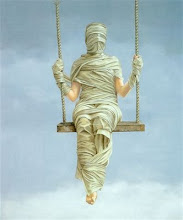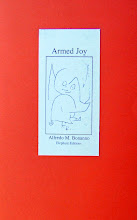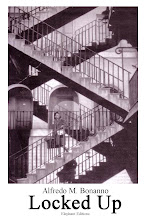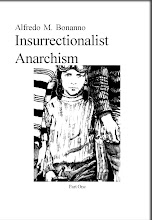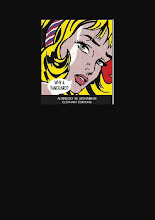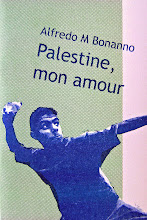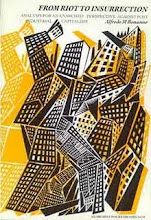Lightning Conductors and Stand-ins
[January 1980]
Preface to the first edition
This pamphlet is a response to Azione Rivoluzionaria’s document ‘Notes for an internal and external discussion’ that appeared in no. 13-14 of ‘Counterinformazione’. The articles “Parafulmini e controfigure” and “L.A.xC.=Nihil” constitute the immediate response of two comrades to AR’s document. Their publication having been refused by two reviews of the movement, it became necessary to spread it autonomously. We are reporting the passages of the review “Insurrezione” that deal directly with the question of ‘armed struggle’, and two articles that appeared in “Anarchismo” n. 21 and n. 23-24, interventions that the text of AR stamp as ‘critique-critique’. We also report a few passages of Vaneigem, who, beyond the confusion and ambiguity, denote a position that is quite far from armed strugglism, in spite of the clumsy attempt of AR to coopt him as ideological inspirer of the more intellectualised terrorism.
Finally, we include a few texts from Apocalisse e rivoluzione (1973) as a contribution to the comprehension and critique of the project of the civil war in vitro, effectively realised a few years later.
Introductive note to second edition
and first chapter
original title: Parafulmini e controfigure
Here is the second edition of this auspicious little book which, obscurely and without kicking up a fuss, marks the original clarifications of the insurrectional orientation within the Italian anarchist movement. By that I mean, let’s be clear, revolutionary anarchist insurrectionalism, not the expectations of the gigantic mass movement that is to destroy all the existent or as much as is necessary in one great day to set things right and give life to the anarchist society. There is no trace of such a way of conceiving insurrectionalism in this little book other than as the postponement to the generalisation of the clash, which could very well abort in nothing - or in tremendous repression - there being no guarantee at all. So, these few, precious pages mark the first steps taken to highlight some critiques, which had become absolutely urgent at the time (1977), concerning the so-called armed organisations (combattent or otherwise).
I hope that this reprint will also be of use to all those with a heartfelt desire to sanctify guerrilla behaviour, which, if on the one hand began with good auspices, ended up taking an anything but acceptable turn. I am referring to the great theoretical-pratical experience of Azione Rivoluzionaria. And the critique raised here against positions that soon began to emerge within this same organisation after a few months’ activity and analytical reflection, was made at the time, contextually, while the iron was hot, showing no mercy to the dead or imprisoned comrades, nor to illusions concerning the fact that we ‘are shooting too’, so we will also ‘win’.
The writer of this introduction (co-author, along with other comrades, of the little book in question), happened to come up with the slogan “only shooting one wins”, and reconfirms that far off affirmation that cost him a two and a half year’s prison sentence in 1972; in fact it is precisely by shooting that one wins. But what does winning mean? Certainly not conquering something. To win also means getting rid of a number of obstacles from the field (men and things), in order to start a new game, the construction of a new world free from all power and it’s abuse, a world that cannot wholly emerge from ‘victory’, but which will probably cost more struggles, more blood, more misunderstandings, etc.
You can only win by shooting if you consider this victory a first, quite modest, step towards the beginning of something really great but which is elsewhere, beyond political calculation or measuring strength, beyond the dazzling action that might fascinate us today, but does not completely convince us. The struggle that develops towards its insurrectional, therefore revolutionary, generalisation, is something that takes a long time and cannot close itself up in the concept of ‘victory’.
The same goes for so-called ‘proletarian justice’. I have come back to this definition more than once when talking of Azione Rivoluzionaria, and I have been retorted: but we should bear in mind that this is a dated concept which, in its time, pointed to the urgency of a practice that certainly wasn’t central: to put those responsible for specific abuses in their place, i.e. flat on their backs, without for that wanting to instore a ‘higher’ conception of justice (proper tribunals, just laws, opportune sentences – all rubbish that has never interested us), but just an indispensible task of cleaning up, even on a large scale, at the moment in which the generalisation of the insurrectional struggle is about to get underway significantly. In conditions of intermediate conflict this kind of response to particular repressive conditions can be seen as a practice of great significance, if nothing other than in preparation for future, far more difficult and articulated tasks. After all, precisely in this ‘neglected’ little book you can find a critique of the concept of ‘proletarian justice’, limited, and rightly so in my opinion, to the possible confusion with a more specific concept of justice, that of the courts, I mean that which strikes everybody every day. Other problems appear. ‘Going into clandestinity’ as I said before, is one. Closing oneself up like a clam, cutting off contact with the human condition that is so difficult to keep repairing in the face of the constant attempts of power to isolate us? Of course, specialisation is always the shortest way to get immediate results. But are these results really what is required? Do we really need a crosscheck to show ourselves how clever we are? To change identity, way of life, places we frequent, build a fictitious universe around ourselves made up of survival and military decisions is all possible, but does that not deprive us of something essential: of what we really are, of what we really could be? It seems to me that today this problem, and these questions, are finding different answers to those that were being put forward at the end of the seventies. There is however a fairly evident new turn. Not to be able to integrate one’s life with what one considers to be one’s revolutionary project is a really wierd condition. One lives out a fantisized version of what should be an adventure in the true sense of the word. That is the situation which, sooner or later, leads to regret and resentment. The fullness of life that one imagined one held the key to starts to fade fast like a cut flower. In times like ours, when all around us there are comrades that have been left with a bitter taste in their mouths, this is something to think about. What have they done (some of them) with their lives? And then, there is the icon. This must be defended at any cost. The little saint, the brand name, the swearing of allegiance. Anyone who refuses to do so has no credibility. How dare they make an about-turn? And when we point out that you can’t go back on something that you never agreed with in the first place, the glittering icon lights up maliciously. One doesn’t discuss, one simply swears on a declaration of faith. Now, there is not a shadow of doubt that a specific anarchist organisation capable of facing the conditions of the clash is indispensable. It is equally without doubt that each one of us contributes - who more, who less - to the construction of this organisation according to their own story and the era in which they carry out their revolutionary activity. I am referring to anarchist and revolutionary comrades here, not to daubers of ink and the chatterers. But it is equally beyond doubt that when forms of the specific organisation start to degenerate, such as happened with Azione Rivoluzionaria at a certain point, critique becomes indispensible, and no sentimental appeal can convince me of the contrary.
This little book includes texts that were part of something in course while debate was still possible, far before the sad conclusion of Azione Rivoluzionaria. Had they been written in the sphere of the decisions that were to end up in in the union of the combattent organisations, they would not have made any sense. And clearly the premises were such as to allow reasonable foundation to the objections being raised. The management of publicity concerning the attacks, just to give an example. Here too - as in the drawing up of the ‘communiques’ - the initial model (discussed and for a short time used by them) of the Angry Brigade, soon became no more than a faded memory. The concise dryness of that incisive model - unique concerning the ‘management’ of actions and ‘relations’ with the press - was soon lost in the claim to ‘explain’, a typical schoolteacher-like attitude that is still hard to die, if not in the minds, certainly in the desire of many comrades.
Then, the important, if not exactly brilliant, big actions (the Moro kidnapping for example), that fill up pages and pages of newspapers. If such a choice is made by a specific organisation instead of limiting itself to small actions of attack and sabotage, this is not so much an oversight or a defect in organisational functioning as a choice of field and, seen from another angle, an inevitable involution towards organisational ‘closure’. If small actions can easily be generalised (as everybody could see in the last half of the eighties and more than half of the nineties), the same cannot be said for the more substantial ones (also without having recourse to the model of the Moro kidnapping), which in their geometrically military distance from the people can do no more than raise a cheer from the stadium.
The critique concerning any organisational model of a specific anarchist armed structure mapped out in this book (and in other writings of mine at the time that were also stigmatised in the “Comuniques”of Azione Rivoluzionaria) still stands today. In any case, being questions of great importance and inexhaustible actuality, I think that they should be meditated upon in depth by any serious comrade.
Trieste 23 December 2000
Alfredo M. Bonanno
Parafulmini e Controfigure
Lightning Conductors and Stand-ins
...for anyone - a latecomer - who has entered consumerism in the role of avant guarde intellectual and wants to stop, there is nothing left to do but put oneself in a desperate and bilious race with the all powerful centres of image production: get taken on as an actor or walk-on. Unpaid actor or walk-on and really dispensed with or in any case liquidated; in this consists the yearned for and beatifying “qualitative” differentiation. (G. Cesarano - G. Collu, Apocalisse e rivoluzione, Dedalo, Bari 1973,
p. 93).
1. The movement of ‘77 and the ‘guerriglia’
The chasing of Lama from Rome University in February 1977 marks the historic rupture of the Italian proletariat with the racket organisations that claimed to control and represent it. In this episode a new movement appeared out of the blue that was incomprehensible for constituted power. In the preceding years capital and its experimenters had constructed in vitro two basic models in which the opposition and the DC-PCI (Christian Democrat - Communist Party) alliance and its programs of hunger and sacrifice was destined to identify itself. The first, mapped out at the Lotta Continua congress in Rimini and the manifestation of the counterculture Circoli del proletariato giovanile, (Proletarian youth circles) tended towards channelling the mass of young people and unemployed towards claims of an essentially cultural character. The lesser of all evils for the system was that the young fight for their right to a new identity and an alternative life-style to be recognised in which, merged together the ideology of the trip, the smugness of drugs, the crying and lamentations about emargination and the ‘crisis of values’, the claim for the right for the most pointless and contradictory to custom. Some self-reduction could be included in the framework of such an ideology. The only thing that shocked the reporters of “L’Unità” and “Corriere della sera” were the expropriations where the mob stocked up with champagne and caviar, thereby showing a refusal of the “content” where the young were to “come together”: ideologies and neo-christian values of poverty, scarcity and the crisis. In the sphere of these “new” ideals the young masses also complained and debated endlessly, not in order to rebel against them and destroy them, but to affirm the dignity of their existential condition and the freedom to decorate themselves with as many feathers and masks as they liked.
The other kind of opposition that power was preparing to neutralize to its advantage was the abstract and specialistic military one. For a long time sociologists had been saying that, with the worsening of the social and economic crisis, the increase in unemployment and the progressive criminalisation of the preventive opponents of the DC-PCI block, an increase in terrorism would also have to be taken into account. Italian capital could willingly accept this challenge, so long as it remained in the military field alone. In fact, this kind of clash (which after a fashion can always be reduced to a technical problem where capital’s forces were superior to those of the enemy from the start), if it carried indubious hardship for the ranks of civil servants and cops, on the other hand presented such advantages as to make it become the lesser of two evils, incomparably preferable to the danger of an illegal violent mass movement of opposition. First of all, the essentially spectacular character of most of the terrorist actions (in particular the murders: the audience love blood) supplied the system with the possibility of turning even the lowest figures of its repressive apparatus into great propagandistic successes; moreover, the development of a limited civil war would induce all the enemies of power to escape from the real daily war into clandestinity and gave the State the opportunity to express its own brand of terrorism to the best of its ability, in a framework of a permanent state of siege and generalised enlistment. Above all, it would freeze the most part - the masses, the people, the proletariat, that the clandestine militant refers to - into the role of indignant spectators, or supporters (electrified by the sensational development and fascinated to live their own ‘adventures’ in dream form, in reality they were reproducing their own condition of powerlessness), in either case, passive participants. Finally, the economy of entrenched camps is in itself a rationing economy, where each one is asked full identification with the crisis diversion; while there is no public order more perfect than that of the sniper and the curfew. As the enemy could be just around the corner, one barricades oneself at home waiting for the right moment in which to unleash no longer revolutionary passion, but compressed rancor and the chain of retaliation. In Europe the precedent of Northern Ireland had already demonstrated how the militarisation of the struggle - wanted as much by the IRA as by the occupying army - supplies an economic and operational outlet for capital, cleans the streets of the combattant yobs of young unemployed and blockades and divides workers affected by avid demands.
The movement of ’77 disrupted all the forecasts of the experts of Italian capital radically . The attack on trades union leader Lama is the expression of uncontrollable, spontaneous, generalised violence, which abruptly shattered all cultural barriers and preconceived generalisations: ‘indians’ and militants of the Autonomia, young ‘hippies’ and organised workers met in action, beyond their respective sociological identities - which for the revolutionaries were certainly not be exalted but abolished, - just like proletariat, i.e. as an historic movement that destroys and goes beyond capital and the demented society produced by it. The nightmare of every power structure takes form and becomes real: proletarians meet without intermediaries, each one autonomously taking charge of solving their own problems and refusing all those - trade unionists, stalinist bureaucrats, militant groupuscules or counter-cultural ideologues - that claimed to speak in their name, and start to organise themselves collectively. Here, in spite of the self-proclaimed vanguards and political specialists – the wildcat workers’ movement find their natural allies and comrades, in the young unemployed, in the mob of the suburbs and universities. The corrupt edifice of the ‘historic compromise’ [Christian Democrats and Communist Party] vacillates under the blows of a mass movement that is violent and armed. This movement - which one month after the attack on Lama’s rally rose up on March 12 in Rome and Bologna - precisely in its practice of violence, demonstrated its total extraneousness not only to the tear-jerking problematic of the specialists of the “personal” and the foreseeable “irony” of so many aspiring intellectuals of the “creative wing”, but also to the logic of the clandestine armed organisations. From the pages of the last issue of “Controinformazione”, Azione Rivoluzionaria accuses the review “Insurrezione” of having revealed the hard-core separateness between the insurgents of March and the specialists of armed struggle: “...the movement of ’77 did not appear from nowhere, it has a history behind it that has also been influenced, it’s hard to deny, by the actions of guerrilla warfare. If people in Rome had limited themselves to irony, Lama would have held his conference at the University and what has become an historic event, Lama being chased out of the University, would simply have been a disturbed conference, even if with intelligence, but all the same a rally, therefore a victory for Lama and his acolytes. It is hard to separate the movement of ’77 from all that was said and done over these years, especially by the armed groups and the autonomous guerrilla». (Azione Rivoluzionaria, Notes for an internal and external discussion in “Controinformazione”, n. 13-14, March 1979 p. 90).
Far from limiting themselves to irony, thousands and thousands of combatants did not hesitate to take arms for themselves when they needed them, looting the gunshops on March 12, while the clandestine militants were worrying about getting out their criticism of these actions as “spontaneist” and “adventurist”, i.e. that escaped their control and were contrary in pratice to any delegation of solving their own problems, including military ones.
Power did not use interpretative patterns that were very different from those of the guerrilla fighters of AR: for the whole of ’77, attempting to repropose the two preconstituted identities - the counter-cultural and the militarist - that the movement had refused, it tried to oppose a ‘creative’ spirit and a ‘combattant’ soul of the movement. In this way politicians, journalists and sociologists as usual understood fuck all of reality, but in recompense tried, on the one hand to manoeuvre the cultural rebels - youth movement, metropolitan indians, feminists etc. - against the development of a determination and coherence of the revolutionary movement, on the other to give credit to the idiocy of the plot plotted by occult paramilitary organizations. The movement had known how to scream in the face of all its paid observers what they really were: IDIOTS!
For their part, neither the cultural vanguards nor the armed vanguards were capable of distinguishing themselves from the servants of power in their understanding of reality. Even less can it be said today that the critiques made by Azione Rivoluzionaria were intelligent: « ... it is possible to put forward the opposite hypothesis: the movement would already have been routed, in its centres, its papers, its radio stations, if the guerrilla had not acted as a lightening conductor, pulling the whole repressive apparatus on to itself ». (Text quoted, p. 90). If the recent wave of arrests of Autonomia Operaia militants accused of the Moro kidnapping clear the field of this nonsense, it is worth considering for a moment the most ambitious of all the actions of the urban guerrilla, precisely the Moro kidnapping. According to Azione Rivoluzionaria, for this undertaking whose «essence lies in the capacity of the revolutionary movement as a whole [and the Brigate Rosse recognise themselves as part of this movement] to deal a blow to the centre». (Text cited, pag. 88). «The clandestine movement paid the price for the psychological war that was unleashed, the suspicion, the Brigatista-hunt, the awakened police-like vocations». (Text cited, p. 89). Apart from undeniable the fact that with the Moro kidnapping power had justified hundreds and hundreds of arrests, charges and arbitrary imprisonment within the movement, and limiting ourselves to remembering that the only concrete request of major repressive rigour made by the PCI to the Christian Democrat government was on the occasion of the closing of the meeting places and the arrest of a series of militants - indicated in their full names – of Autonomia Operaia of Rome, the BR had turned their blow “to the centre” of the revolutionary tension that persisted, even though fully in the phase of reflux, in Rome for more than a year, arrogantly imposing the spectacle or symbol of the revolutionary struggle on everybody’s attention. In the incredible atmosphere of these days inevitably perceived as irrelevant, i.e. not wanted, not lived and not understood by revolutionaries, it became possible to nail the masses down again to the passivity similar to watching a film. After a year of determined struggles carried out by subjects acting autonomously in daily reality common to everybody, they turned in on themselves at the mercy of external forces that move not only the will but also everybody’s consciousness from above. Held between these far-off forces one was pushed to choose under the pressure of real blackmail: one had to take sides, delegate once again. If the State could impose its own infamous blackmail on everybody (‘either with me or with terrorism’), the BR was asking everybody to dream: or rather to cheer them, or develop the more ‘radical’ intention to one day enter the game of heroes. This has been the message of the BR: enroll, or stay at home, put on the TV and clap your hands: that had always been the message of the clandestine organisations: the Moro action simply brought it into everybody’s home and in this way obliged all those who wanted to remain faithful to their own revolutionary subjectivity to radically reject it.
2. The hierarchy of the ‘Popular Front’ of the clandestine organisations: actors and stand-ins. With clumsy zeal Azione Rivoluzionaria makes the blackmail that had always been concealed by the bureaucratic-political language of the BR proclamations explicit: «The critique critique that tends to isolate guerrilla warfare from the movement is perfectly functional to the plan of repression that uses violence against the guerrilla and uses critique (from Asor Rosa to the passionless cynics) to isolate it. The ‘critique critique’, that knows everything, does not know that by isolating the guerrilla it is also preparing the conditions for its own precipitation into clandestinity, unless capital, in its great ingeniousness, just as it does not know today how to recognise its friends and tortures, kills, persecutes the terrorists, tomorrow will not know how to recognise as its sole enemy the critique critique and guarantees it chairs and podiums». (Testo citato, p. 90) Without staying to confute the Christian imbecility of those who want to see the truth of a faith demonstrated by the martyrdom of its followers, what immediately comes to mind, reading this infamous passage, is the blackmail directed for 50 years by stalinism against all the international opposition (the same that Lenin had directed against Kronstadt and the Workers Opposition): ‘Russia, home of socialism, is threatened by the imperialists and to defend it thousands and thousands of proletarians all over the world have sacrificed themselves: so if you criticise Russia, you are obstructing internal or foreign politics etc., you are useful to imperialism, or rather you are nothing but a cover, a mask, agents of disguised international fascism’. Azione Rivoluzionaria launches all this against whoever criticises the clandestine struggle in a document in which they make no critique of the stalinists of the BR, allied in the process of construction of the guerrilla.
The complicity of the anarchists in the counter-revolution in Spain in 1936-37 demonstrates with a thousand examples such as, who sleeps with dogs wakes up with fleas, so who goes with the stalinists learns to slander the revolutionaries. As in Spain, there exists today in Italy a Popular Front, minoritarian and clandestine, of course, but which aspires, like that of the past, to become majoritarian and in power, to gather in its ranks the impetus of the revolutionary proletariat. An even minimal knowledge of revolutions and counterrevolutions of the past clarifies that within every popular front there exist very rigid hierarchies that correspond to different specific gravity of the organisations that make them up. For example in the Spain of 1936-37 the tiny Communist Party had enormous authority inside the Popular Front, superior to that of the anarchists, even though the latter were the major force of the Spanish proletariat. The present front of clandestine organisations has an essentially spectacular result: that is why the Fronte Popolare is not a question of sharing out the ministries of a counterrevolutionary government, but also in this case the Front has its internal hierarchy: while the role of protagonist and main actors are indiscussibly assigned to the stalinists, nothing remains for the strange libertarians of Azione Rivoluzionaria but the role of stand-in. To the Brigatisti the titles of the dailies and the cheers of the passive admirers; to the anarchists ugly downfalls and acts at breakneck speed.
3. Critique of daily life
«Only (and we excuse the critique critique here) real autonomy in the armed project against all aspects of social life, the constitution of a network of resistance and attack on the vital centres of exploitation and death, living one’s life fully, aware of already being partly outside the grip of capital, can allow this road to liberation to begin. But even here, at the level of the operating subject, just as at the social level, it is necessary to cut one’s bridges with daily normality, create a situation of no return, go into clandestinity». (Testo citato, p. 90). Thus guerrillas of Azione Rivoluzionaria ammoniate the critique of daily life. We have already said how, in realty, the “strategic choice of clandestinity” never gave the militants of Azione Rivoluzionaria anything more than “liberation” in the catastrophic role of stand-in. To the opposite, radical critique, which the Azione Rivoluzionaria document (which among other things copies all the critical thematics “Insurrezione”, except for insulting its own source, to which it attributes positions that are totally invented) tries to recuperate some positions, for example, Vaneigem, who has never expressed any sympathy for political terrorism, and has on the contrary always fought hard the positions of armed immediatism like that of the document of Azione Rivoluzionaria. It is clear therefore that when a pratice that explicitly places its discriminant in the “strategic choice of clandestinity” one is making one’s own positions, for example on the critique of daily life, exclusively with the aim of recuperation.
The only radical position to take before the existent is today, that of those who from their specific position in society (the situation in which most spontaneously and sincerely they develop their social relations, communication, love, friendship) are facing real war – daily and without quarter – against capital and its interiorisation. That means above all struggle against the organisation of one’s own life according to the world of appearances, images – therefore struggle against the interiorisation of the codes of behaviour that capital is constantly producing, renewing and transmitting. To want to be revolutionaries, i.e. to want live the possible adventure of life according to one’s own material passions and one’s own living senses, implies the radical refusal of identification with any social determination of capital, with any identity, preconstituted and fictitious mask, that that hides and mystifies the dynamic of life. It is in perceiving oneself as body in movement, recognising one’s passions for what they are, that is, irreducible to the society of symbols and its organisation, and arming oneself against it, that it is possible for each one to find the sense of a unique and specific life. And it is at this point that necessity presents itself and along with it opens up the possibility to comunicate the armed project against capital and live in the community that surrounds us. Any coherent revolutionary praxis that recognises the falsity of all the social identities proposed by capital and fights all of them, knowing them to be, in the most violent and sectarian forms, absolutely clandestine for the spectacle, knows that it is elsewhere. Certainly who lives this elsewhere in immediate or geographical terms has not the faintest idea of where they are: there is no other field of battle than the world dominated in total by capital, inside and outside individuals, and from this world, this battle, there is no escape. Who knowingly fights the real war both inside and outside himself, might find clandestinity an unavoidable necessity in some cases, but always just one more obstacle to overcome in the battle for one’s own transparency and coherence. Those who fictitiously push away their ‘normal’ social identity to choose the heroic and spectacularly hyperevaluated one of the “guerrilla warrior”, clandestine for the real movement as much as for the police, come to find themselves today, due to one of the tricks that the spectacular optic plays, not only at the centre of the shoot-outs, but also at the centre of the fire of the cameras, at the centre of the spectacle. What was to have been a struggle against value becomes the ultimate valorization possible of the personality of the militant, the ultimate sacrificial rite capable of producing value. As the strange libertarians of Azione Rivoluzionaria declare, it is true that the spreading of the clandestine military practice democratises today this possibility of self-valorization: « every village, every city, now has its stage and its actors; violence is a spectacle available to anyone of good will ». (Text cited, p. 90). In the same way, but from an opposite point of view, it is true that revolutionary violence, if it wants to be, destroys every stage and every spectacle and knows how to see in all actors the natural enemies of truth and overcoming.
[May ’79]


